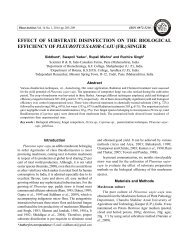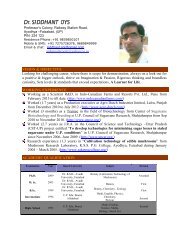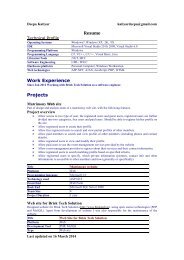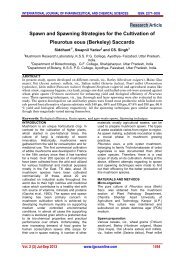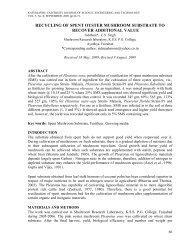Conversion of Crop Waste in to Pink Oyster Mushroom Pleurtus eous
You also want an ePaper? Increase the reach of your titles
YUMPU automatically turns print PDFs into web optimized ePapers that Google loves.
Trends <strong>in</strong> Biosciences 6 (4): 418-420, 2013<br />
<strong>Conversion</strong> <strong>of</strong> <strong>Crop</strong> <strong>Waste</strong> <strong>in</strong> <strong>to</strong> P<strong>in</strong>k <strong>Oyster</strong> <strong>Mushroom</strong> <strong>Pleurtus</strong> <strong>eous</strong><br />
1 2 3<br />
SIDDHANT SWAPNIL YADAV AND C.S. SINGH<br />
1<br />
<strong>Mushroom</strong> Research Labora<strong>to</strong>ry, K.S.S. P.G. College, Ayodhya- Faizabad, (U.P.) India<br />
2<br />
Department <strong>of</strong> Biotechnology, Gandhi Faiz-e-Aam P.G. College, Shahjahnapur, (U.P.) India<br />
3<br />
Department <strong>of</strong> Botany, K.S.S. P.G. College, Ayodhya- Faizabad, (U.P.) India<br />
e-mail: siddhant.ani@gmail.com<br />
ABSTRACT<br />
The present study deals with the use <strong>of</strong> ten locally<br />
available crop wastes, viz., banana pseudostem ( Musa<br />
spp .), mustard husk ( Brassica campestris), mustard stem<br />
( Brassica campestris), dry fruit <strong>of</strong> Ridge gourd ( Luffa<br />
aegyptiaca), groundnut shell ( Arachis hypogaea), maize<br />
cob ( Zea mays), paddy Straw ( Oryza sativa), pea straw<br />
( Pisum sativum), rice husk ( Oryza sativa) and <strong>to</strong>bacco stem<br />
( Nicotiana tabacum) for various parameters <strong>of</strong> mushroom<br />
production. Results regard<strong>in</strong>g the time required for<br />
spawn runn<strong>in</strong>g, primordial development and maturation<br />
<strong>of</strong> fruit<strong>in</strong>g bodies on different substrates showed that they<br />
appeared earlier on paddy straw and also gave significant<br />
biological efficiency (66%) than the control.<br />
Key words Biological efficiency, <strong>Crop</strong> wastes, Pleurotus<br />
<strong>eous</strong>,<br />
The lignocellulosic complex constitutes a major portion<br />
<strong>of</strong> the <strong>to</strong>tal carbon fixed by pho<strong>to</strong>synthesis. However, only a<br />
small fraction <strong>of</strong> cellulose, hemicellulose and lign<strong>in</strong> produced<br />
as agricultural by-product is utilized; most <strong>of</strong> this material is<br />
considered waste material. The abundant availability <strong>of</strong><br />
wastes pose problem <strong>of</strong> disposal. Bio-conversion <strong>of</strong> these<br />
renewable wastes would solve pollution problems and also<br />
these organic wastes may become available for soil<br />
enrichment. Bio-degradation <strong>of</strong> various agro and agro<strong>in</strong>dustrial<br />
wastes could be accomplished through several<br />
micro organisms <strong>to</strong> degrade lignocellulosic complex. Among<br />
the microbes, mushrooms were known <strong>to</strong> produce extra<br />
cellular enzymes like manganese peroxidase (Martínez, et al.,<br />
1994) , laccase (Das, et all, 2001, Platt, et all 1984,<br />
Teradimans, et all 2002 ) lign<strong>in</strong> peroxidase and aryl alcohol<br />
oxidase(Upadhyay, and Fritche, 1997) <strong>to</strong> degrade<br />
lignocellulosic complex. Hence, biological pretreatment <strong>of</strong><br />
lignocellulosic wastes with mushroom may become<br />
economically and environmentally attractive.<br />
The cultivation <strong>of</strong> mushrooms on agricultural and animal<br />
wastes is a very old practice <strong>in</strong> European countries, but <strong>in</strong><br />
India and other develop<strong>in</strong>g countries it is ga<strong>in</strong><strong>in</strong>g popularity<br />
day by day. The cultivation <strong>of</strong> p<strong>in</strong>k oyster mushroom is less<br />
documented, therefore, there is a vast scope <strong>of</strong> study <strong>in</strong> respect<br />
<strong>of</strong> its cultivation.<br />
Keep<strong>in</strong>g this <strong>in</strong> m<strong>in</strong>d, present study was under taken <strong>to</strong><br />
evaluate different locally available crop wastes for better<br />
productivity <strong>of</strong> this mushroom species.<br />
MATERIALS AND METHODS<br />
Micro-organism:<br />
The pure culture <strong>of</strong> Pleurotus <strong>eous</strong> (Berk) Sacc. was<br />
obta<strong>in</strong>ed from the mushroom section <strong>of</strong> Plant Pathology<br />
Department, Chandra Shekhar Azad University <strong>of</strong><br />
Agriculture and Technology, Kanpur (U.P.) India. The culture<br />
was ma<strong>in</strong>ta<strong>in</strong>ed and subcultured on pota<strong>to</strong> dextrose agar<br />
(PDA) medium.<br />
Spawn strategy:<br />
Wheat gra<strong>in</strong>s ( Triticum aestivum) were used as a spawn<br />
substrate. The spawn was prepared by the Conventional<br />
method.<br />
Substrate preparation:<br />
The substrates used for cultivation <strong>of</strong> Pleurotus <strong>eous</strong><br />
were banana pseudostem ( Musa spp .), mustard husk<br />
( Brassica campestris), mustard stem ( Brassica campestris),<br />
dry fruit <strong>of</strong> ridge gourd ( Luffa aegyptiaca), groundnut shell<br />
( Arachis hypogaea), maize cob ( Zea mays), paddy Straw<br />
( Oryza sativa), pea straw ( Pisum sativum), rice husk ( Oryza<br />
sativa) and <strong>to</strong>bacco stem ( Nicotiana tabacum). These were<br />
compared <strong>to</strong> wheat straw ( Triticum aestivum) which had been<br />
recommended as the best substrate for mushroom cultivation<br />
sungh sungh 1994. The substrates were collected, cleaned, air<br />
dried and chopped <strong>in</strong>-<strong>to</strong> small pieces <strong>of</strong> about 1 cm length and<br />
filled (500 g) <strong>in</strong> polypropylene bags (42×30 cm size). These<br />
were washed separately <strong>in</strong> fresh water and then pasteurized <strong>in</strong><br />
the solution <strong>of</strong> formaldehyde (500ppm) and Bavist<strong>in</strong> (75ppm)<br />
for 18 h as recommended by Vijay, and Sohi, 1987.<br />
Method <strong>of</strong> cultivation:<br />
The beds were prepared from pasteurized substrate by<br />
layer spawn<strong>in</strong>g follow<strong>in</strong>g the procedure <strong>of</strong> Bano, 1971 . These<br />
were <strong>in</strong>cubated <strong>in</strong> a cultivation room at 22-30°C temperature<br />
for spawn run. When the mycelium had completely covered<br />
the beds, the polythene cover<strong>in</strong>g was taken <strong>of</strong>f and the relative<br />
humidity was ma<strong>in</strong>ta<strong>in</strong>ed 85-95 per cent with the help <strong>of</strong><br />
humidifier.<br />
Data concern<strong>in</strong>g and Biological efficiency:<br />
The yield parameters recorded were, time lapsed <strong>in</strong><br />
spawn runn<strong>in</strong>g, p<strong>in</strong> head <strong>in</strong>itiation and maturity <strong>of</strong> fruit<br />
bodies, number <strong>of</strong> flushes, mushroom yield, biological<br />
efficiency, <strong>to</strong>tal number and weight per sporocarp on different<br />
crop waste. The biological efficiency <strong>of</strong> mushroom was
419 Trends <strong>in</strong> Biosciences 6 (4), 2013<br />
worked out as percentage yield <strong>of</strong> fresh mushrooms <strong>in</strong><br />
relation <strong>to</strong> the dry weight <strong>of</strong> the substrate accord<strong>in</strong>g <strong>to</strong> Chang<br />
and Miles, 1989.<br />
Statistical analysis:<br />
Completely randomized design (CRD) was followed for<br />
the experiment. All data were statistically analysed. The<br />
critical difference (CD) was processed at the five per cent<br />
probability level.<br />
RESULTS AND DISCUSSION<br />
<strong>Mushroom</strong> production recorded <strong>in</strong> the experiment is<br />
shown <strong>in</strong> Table 1. Pleurotus <strong>eous</strong> utilized all substrates for<br />
mycelial growth and fruit body development. The substrates<br />
had variable effect on duration <strong>of</strong> spawn runn<strong>in</strong>g, <strong>in</strong>itiation<br />
and maturation <strong>of</strong> fruit bodies, which ranged from 10-28 days,<br />
13-37 days and 17-41 days, respectively (Table1). As<br />
compared <strong>to</strong> control (15, 18, 22 days) the paddy straw<br />
substrate (10, 13, 17 days), pea straw (12, 14, 18 days), maize<br />
cob (12, 15, 19 days) and mustard stem (12, 16, 20 days) had<br />
shorter time recorded for those stages. The rest <strong>of</strong> the<br />
substrates showed longer duration, be<strong>in</strong>g, the maximum<br />
period recorded on rice husk (28, 37, 41 days).<br />
Yield data <strong>of</strong> fresh mushrooms revealed that only paddy<br />
straw gave higher yield and biological efficiency (330 g,<br />
66%) than the control. Mustard stem (310 g, 62%), and pea<br />
straw (315 g, 63%) were similar <strong>to</strong> wheat straw alone. The rest<br />
<strong>of</strong> the substrates particularly the rice husk (30g, 6%) gave<br />
poor yields and biological efficiency.<br />
The number <strong>of</strong> fruit bodies harvested varied among the<br />
substrates Studied. Pea straw (67) produced the highest<br />
number <strong>of</strong> sporocarps while paddy straw (50), mustard stem<br />
(53) and banana pseudo stem (52) were higher than control<br />
(44). Average weight <strong>of</strong> sporocarps ranged from 2.14-6.84 g.<br />
(Table1)<br />
The mushroom growth directly<br />
depends upon the amount <strong>of</strong> nutrients present <strong>in</strong> the substrate<br />
and their availability <strong>to</strong> fungus. The growth <strong>of</strong> Pleurotus <strong>eous</strong><br />
on diverse range <strong>of</strong> substrates <strong>in</strong>dicated that the all substrate<br />
materials meet the nutritional requirements desired for fungal<br />
growth. The primordial development depends on the substrate<br />
used. Material with high quality <strong>of</strong> lign<strong>in</strong> and cellulose<br />
contents take a longer time <strong>to</strong> <strong>in</strong>itiate the p<strong>in</strong>n<strong>in</strong>g compared <strong>to</strong><br />
the substrate with low content <strong>of</strong> lign<strong>in</strong> and cellulose. Due <strong>to</strong><br />
very low lign<strong>in</strong> content <strong>in</strong> straw, pea and paddy straw <strong>to</strong>ok<br />
shorter period for p<strong>in</strong>n<strong>in</strong>g. The yield and biological efficiency<br />
varied among the substrates. The mushrooms which grow on<br />
waste material are capable <strong>of</strong> degrad<strong>in</strong>g various substrate<br />
components but all <strong>of</strong> them are not similar <strong>in</strong> their enzymatic<br />
activities and therefore, they show preference for specific<br />
substrate. Probably due <strong>to</strong> this reason, yield variation was<br />
noticed among the substrates. The significant higher yield and<br />
biological efficiency was observed on paddy straw substrate.<br />
This was <strong>in</strong> conformity with who reported greater sporophore<br />
production on paddy straw than wheat straw.<br />
ACKNOWLEDGEMENT<br />
The authors are thankful <strong>to</strong> Dr. B.P. Kanaujia, C.S.A.<br />
University <strong>of</strong> Agriculture and Technology, Kanpur for<br />
provid<strong>in</strong>g the culture <strong>of</strong> Pleurotus <strong>eous</strong> and the pr<strong>in</strong>cipal
SIDDHANT et. al. : <strong>Conversion</strong> <strong>of</strong> <strong>Crop</strong> <strong>Waste</strong> <strong>in</strong> <strong>to</strong> P<strong>in</strong>k <strong>Oyster</strong> <strong>Mushroom</strong> <strong>Pleurtus</strong> <strong>eous</strong><br />
420<br />
K.S.S.P.G. College, Ayodhya- Faizabad for labora<strong>to</strong>ry and<br />
library facilities.<br />
LITERATURE CITED<br />
Bano, Z. 1971. Cultivation <strong>of</strong> Pleurotus flabellatus. Second<br />
Int. Symp. Pl. Pathol., New Delhi. (Abstract No. 135).<br />
Chang, S.T. and. Miles P.G. 1989. Edible mushrooms and<br />
their cultivation, CRC Press, Boca Ra<strong>to</strong>n, pp. 256-274.<br />
Das, N., Chakraborty, T.K. and. Mukharjee. M 2001.<br />
Purification and characterization <strong>of</strong> a growth<br />
regulat<strong>in</strong>g Laccase from Pleurotus florida.<br />
J. B.<br />
Microbiol., 41(5):261-267.<br />
Platt, M.W., Hadar Y. and Chet.I. 1984. Fungal activities <strong>in</strong><br />
lignocellulose degradation by Pleurotus. Appl.<br />
Microbiol. Biotechnology. 20: 150-154.<br />
Teradimans, M.T., Marimuthu S., Juliot H. and<br />
Siddeswaram K.. 2002. Correlation <strong>of</strong> cellulose and<br />
laccase activities with coir pith decomposition by white<br />
rot fungi. <strong>Mushroom</strong> Res., 11: 21-24.<br />
Upadhyay, R.C. and Fritche W. 1997. Lign<strong>in</strong>olytic enzymes<br />
<strong>of</strong> Pleurotus species, Advances <strong>in</strong> <strong>Mushroom</strong> Biology<br />
and Production (eds. Rai, R.D., Dhar, B.L. and R.N.<br />
Verma) MSI, Solan<br />
Received on 04-06-2013 Accepted on 15-06-2013





